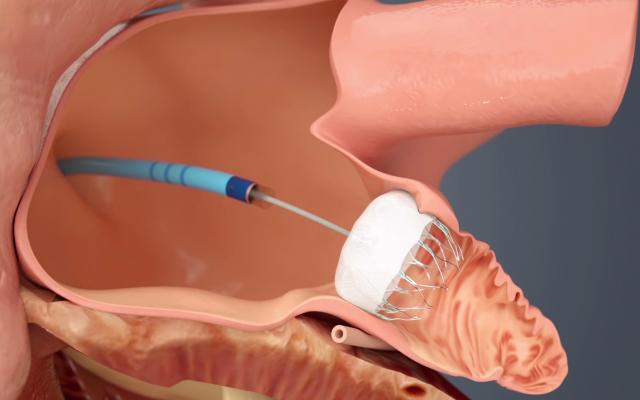LAAO is done by a doctor called an electrophysiologist. An electrophysiologist is a heart doctor (cardiologist) that treats abnormal heart rhythms. To do LAAO, the doctor puts a catheter (long, thin wire) into a blood vessel and passes it into the heart.
Most of the time, this procedure is done through a vein on the right side of the groin (called the femoral vein). In rare cases the procedure is done through veins on both sides of the groin. The doctor also injects a dye (contrast media) to help guide the device and make sure it fits well in the left atrial appendage (LAA).
When the catheter reaches the heart, it will go into the right atrium. The catheter will be passed from the right atrium to the left atrium by making a small hole in the wall (called the septum) between these 2 upper chambers of the heart.
The LAAO device is passed through the catheter into the LAA.
Implanted LAAO Device

Source : Boston Scientific, 2015, Watchman Patient Guide
The electrophysiologist makes sure that the device is in the right place within the LAA. They open the device that is tightly folded in the catheter, much like opening up a folded umbrella.
When the procedure is done, the catheter is removed and only the LAAO device stays in the body. LAAO takes 2 to 4 hours.
What are the risks of LAAO?
The main risks of LAAO include:
- bleeding or bruising where the catheter went in the groin
- damage to the femoral veins from the catheter – To lower your risk, rest in bed for a few hours after the procedure.
- clots within your heart or around the catheters – You will get a blood thinner during LAAO to lower this risk.
- damage or a tear to the heart muscle or valve
- a hole in the heart that causes blood to leak into the sac around it – This blood may be drained by placing a needle in the sac or in some cases open heart surgery is needed.
Only 1 or 2 out of 100 people having an LAAO will have a complication.
Getting ready for LAAO
Don’t eat or drink anything after midnight on the day before your procedure. Be at the hospital on time and go to the department where you’re having your procedure.
At the department you will:
- change into a gown
- get an IV (intravenous) in your arm
- meet with the doctor who will explain the procedure and answer your questions
- sign the consent form (once you understand the procedure and if you haven’t already signed one)
When the procedure is ready to begin, you will go to the electrophysiology (EP) Lab where you will:
- lie on a narrow bed
- get ECG electrodes and other patches will be put on your back and chest (these are taken off after the procedure)
- get a general anesthetic (sleeping medicine) to help you stay comfortable during the procedure
- get freezing or anesthetic to numb your groin where the catheter will be passed
After the LAAO
- When the procedure is done, the doctor will close the opening in the groin with a stitch. This stitch is taken out before you go home.
- You’ll go to the post-anesthetic care unit (also called the PACU or recovery room) right after the procedure. Once you wake up from the procedure, you’ll go to another unit of the hospital where you’ll lie flat for 3 hours to prevent bleeding.
- You’ll stay in the hospital overnight and go home in the morning.
- Before you leave the hospital, you’ll get an identification (ID) card that says you have an implanted device. Keep this ID card with you and show it anytime you see a doctor, dentist, or go to an emergency department.
When to go to the hospital
Go to an emergency department if you:
- have chest pain
- have trouble breathing
- are dizzy, feel like you may pass out, or if you’ve fainted
Don’t drive yourself if you don’t feel well. Have someone drive you or call 911.
If you go to the emergency department or see a doctor for any issues related to your LAAO procedure, please call the clinic the same day or the next day.
